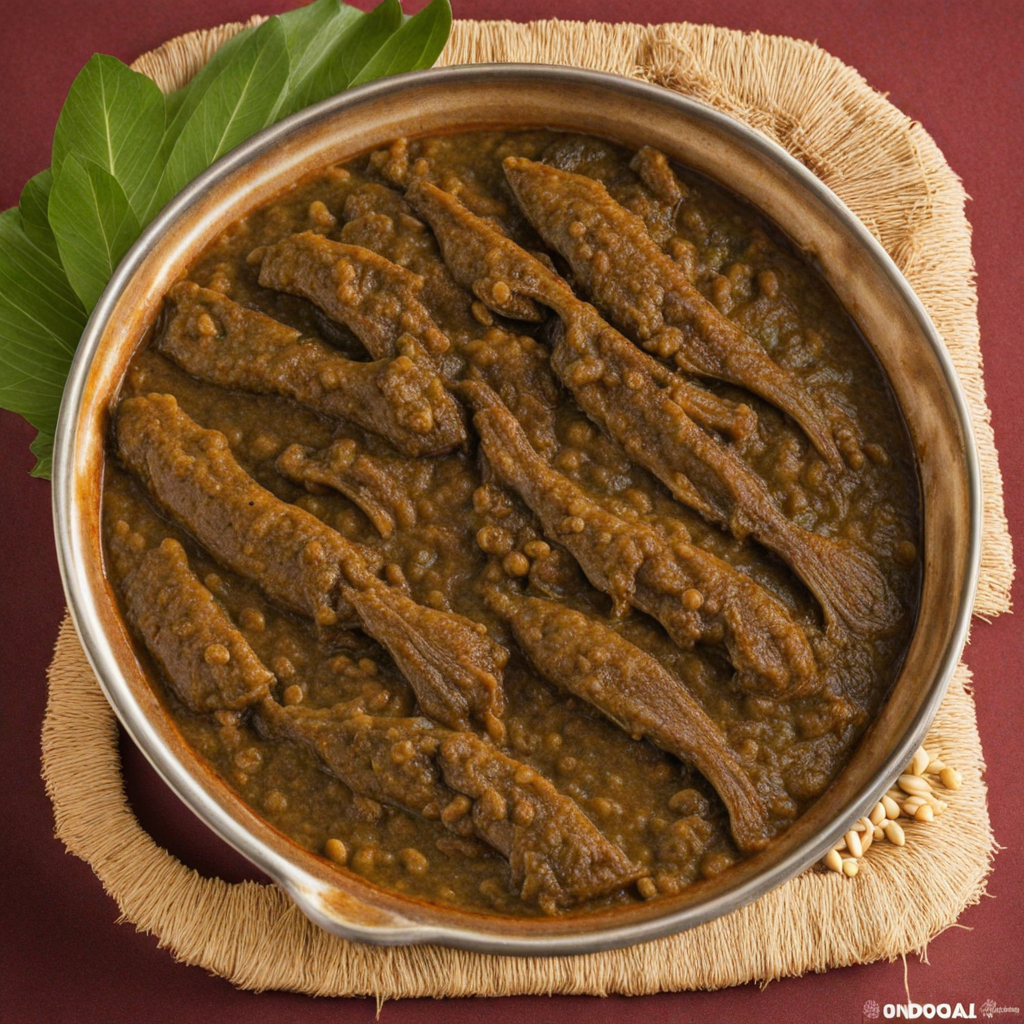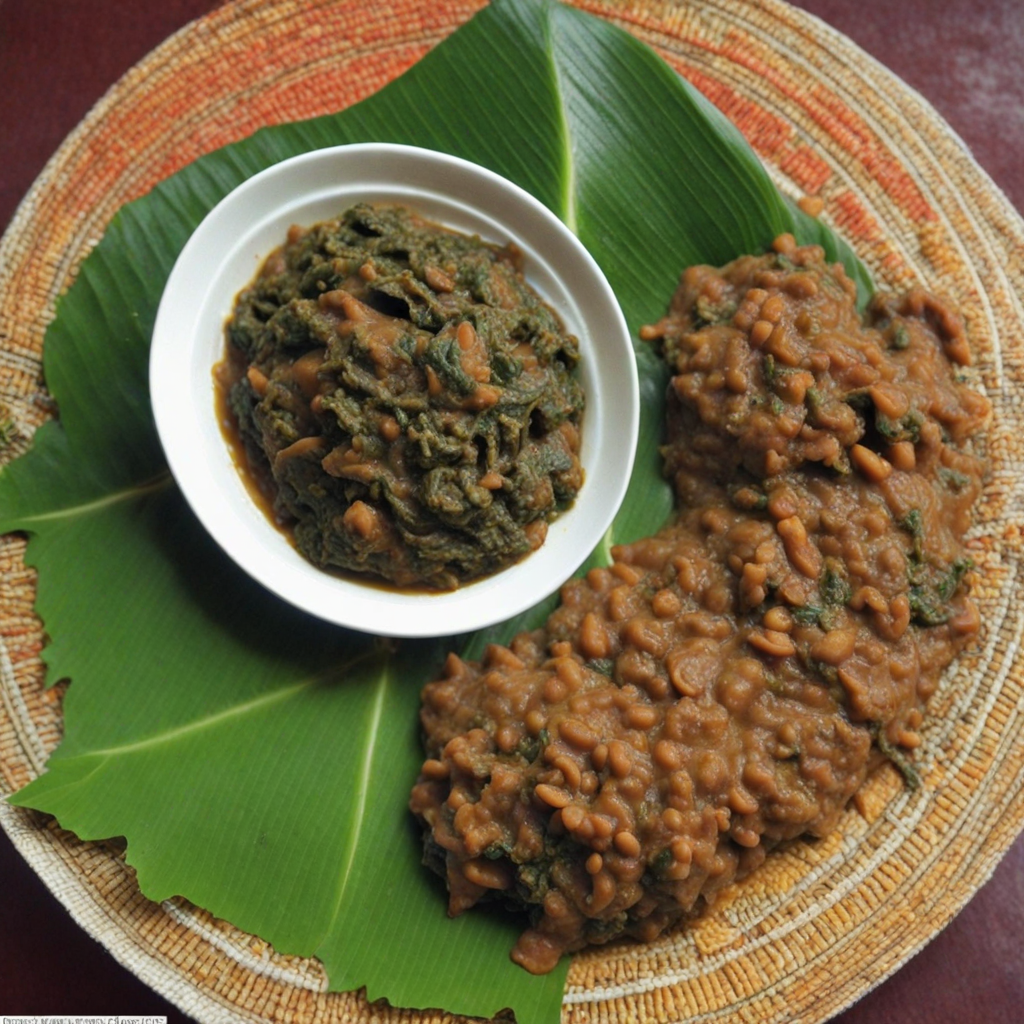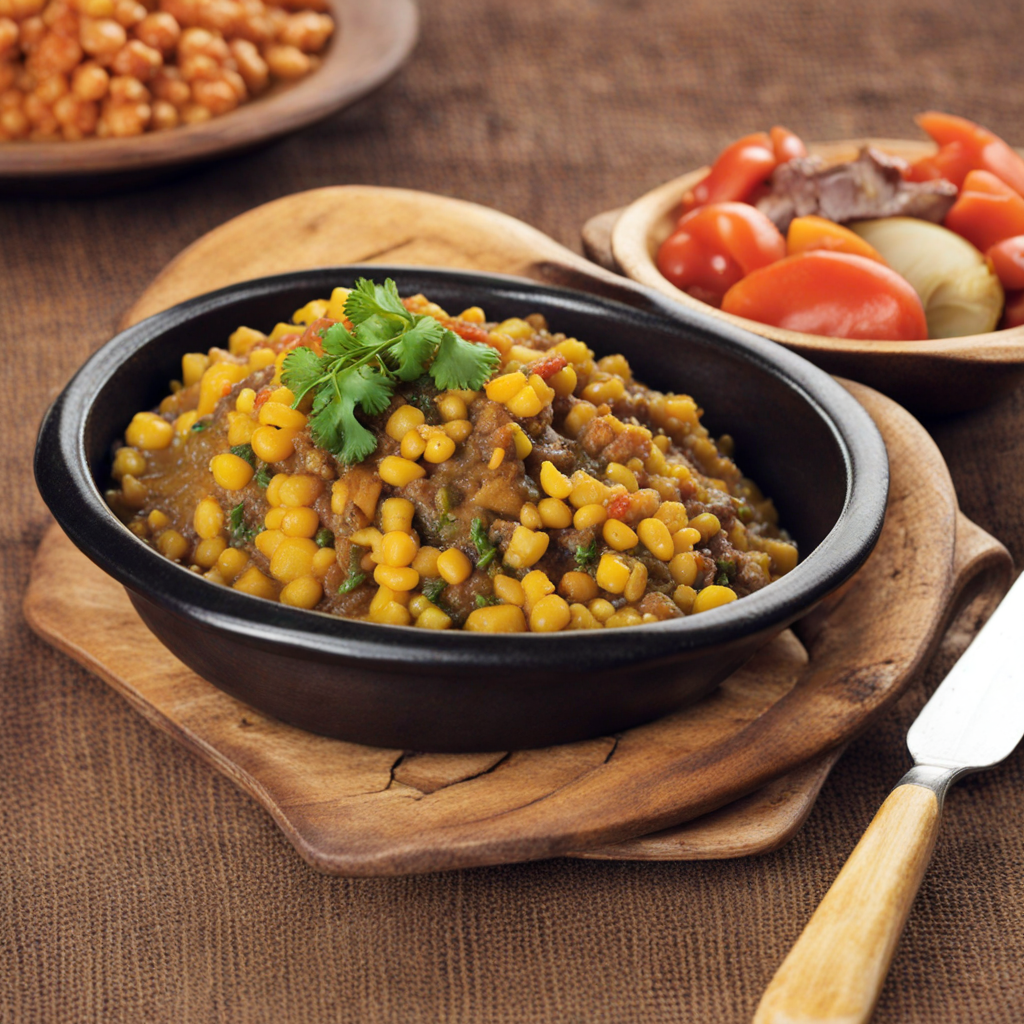Ndoleh
Ndoleh is a traditional Zambian dish that showcases the rich culinary heritage of the region. At its core, Ndoleh is a vibrant vegetable stew primarily made with fresh, locally sourced ingredients. The star of the dish is typically the leafy green vegetable known as 'bitter leaf' or 'ndoleh' itself, which imparts a distinct earthy flavor. The leaves are often complemented by a medley of other vegetables, such as tomatoes, onions, and peppers, all simmered together to create a harmonious blend of tastes and textures. The dish is often enriched with groundnut (peanut) paste or crushed groundnuts, adding a creamy consistency and a nutty undertone that elevates the overall flavor profile. The preparation of Ndoleh often involves a careful cooking process where the vegetables are sautéed to bring out their natural sweetness before being combined with the groundnut paste. This method not only enhances the flavors but also ensures that the nutrients from the vegetables are retained. The dish is typically seasoned with spices, such as salt, pepper, and sometimes a hint of chili, giving it a delightful warmth. The balance of flavors is what makes Ndoleh so inviting; the slight bitterness of the leaves is beautifully countered by the richness of the groundnuts and the freshness of the other vegetables. Ndoleh is versatile and can be served as a main dish or as a side alongside staples like nsima (a type of cornmeal porridge) or rice. Its hearty nature makes it a satisfying meal, providing a comforting experience while celebrating the essence of Zambian cuisine. For those looking to explore new tastes, Ndoleh offers a unique combination of bitterness, nuttiness, and freshness that is sure to leave a lasting impression on the palate.
How It Became This Dish
The Delicious Journey of Ndoleh: A Culinary Gem from Zambia #### Introduction Ndoleh is a cherished dish in Zambian cuisine, known for its vibrant flavors and nutritious ingredients. This dish, primarily made from groundnut (peanut) sauce and indigenous vegetables, represents more than just a meal; it embodies the history, culture, and agricultural heritage of Zambia. Its origins, cultural significance, and evolution over time reflect the interplay between local traditions and modern influences, making Ndoleh a fascinating topic in the culinary landscape of Southern Africa. #### Origins of Ndoleh The roots of Ndoleh can be traced back to the agricultural practices of the various ethnic groups in Zambia, particularly among the Bantu-speaking peoples. The Bantu migration, which began around 1000 AD, brought agricultural skills and knowledge of various crops and cooking techniques to the region. Groundnuts, a staple legume in Southern Africa, were among the crops that flourished in Zambia's fertile soils. This nutty legume became a critical source of protein and fat, essential for the diets of many Zambians. The dish itself combines groundnut sauce with leafy greens, typically spinach or other indigenous vegetables like pumpkin leaves or cassava leaves. These greens are rich in vitamins and minerals, making Ndoleh not only a delicious dish but also a nutritious one. The combination of groundnuts and leafy greens symbolizes the Zambian ethos of resourcefulness and the ability to create hearty meals from locally sourced ingredients. #### Cultural Significance Ndoleh holds a special place in Zambian culture, often featured in traditional ceremonies and gatherings. It is not just a dish; it is a symbol of hospitality and community. During important occasions such as weddings, funerals, and festivals, Ndoleh is prepared and shared among family and friends, reinforcing social bonds and cultural identity. In many Zambian communities, the preparation of Ndoleh is a communal activity. Women gather to cook, sharing stories and laughter, which strengthens their relationships. This aspect of communal cooking highlights the role of food in fostering connections within communities, making Ndoleh a dish that transcends mere sustenance. Moreover, Ndoleh is often served with nshima, a staple food made from ground maize, which serves as the backbone of Zambian cuisine. The combination of nshima and Ndoleh creates a well-rounded meal, showcasing the balance of flavors and textures that are hallmarks of Zambian cooking. Nshima's blandness complements the rich, earthy flavors of Ndoleh, emphasizing the importance of harmony in Zambian culinary traditions. #### Evolution Over Time As Zambia has transitioned through various historical phases, so too has Ndoleh evolved. The colonial period brought about significant changes in agricultural practices, trade, and food consumption patterns. European influence introduced new ingredients and cooking methods, but traditional dishes like Ndoleh remained resilient, adapting while preserving their core characteristics. In contemporary Zambia, Ndoleh has gained recognition beyond local borders, becoming a symbol of Zambian cuisine on the international stage. Zambians living abroad have introduced Ndoleh to diverse audiences, leading to a growing appreciation for this unique dish. As globalization spreads, fusion versions of Ndoleh have begun to emerge, incorporating ingredients from other culinary traditions while maintaining the essence of the original recipe. Furthermore, the rise of health consciousness among consumers has brought renewed attention to Ndoleh's nutritional benefits. With its high protein content from groundnuts and the abundance of vitamins from leafy greens, Ndoleh is increasingly seen as a wholesome option for health-conscious eaters. This has led to a resurgence in the popularity of traditional Zambian dishes, as people seek to reconnect with their roots and embrace healthier eating habits. #### The Role of Ndoleh in Modern Zambian Society Today, Ndoleh is more than just a beloved traditional dish; it is a symbol of national pride for many Zambians. As the country celebrates its culinary heritage, Ndoleh has become a staple at food festivals and cultural events. Chefs and home cooks alike are experimenting with new interpretations of the dish, blending traditional methods with modern culinary techniques. Zambia's culinary landscape is also being shaped by younger generations who are eager to explore and promote their cultural identity through food. Social media platforms have become a vital space for sharing recipes, cooking tips, and the stories behind traditional dishes like Ndoleh. This digital revival is helping to preserve the cultural significance of Ndoleh while simultaneously introducing it to a global audience. Moreover, Ndoleh's preparation often reflects individual family traditions, with each household adding its unique twist to the recipe. This diversity in preparation methods showcases the adaptability of Ndoleh, allowing it to resonate with various tastes and preferences while remaining true to its roots. #### Conclusion Ndoleh is more than just a dish; it is a reflection of Zambia's rich cultural tapestry and agricultural heritage. From its origins in the Bantu migrations to its place in contemporary Zambian society, Ndoleh has evolved while preserving the traditions and values of its people. As Zambia continues to navigate the complexities of globalization and modernity, the enduring appeal of Ndoleh serves as a reminder of the importance of food as a vessel for cultural expression and community cohesion. In an increasingly interconnected world, Ndoleh stands as a testament to the power of traditional cuisine to foster identity, connection, and pride. As people around the globe seek to explore Zambian flavors, Ndoleh invites them to savor not only its delicious taste but also the rich history and cultural significance behind each bite.
You may like
Discover local flavors from Zambia







